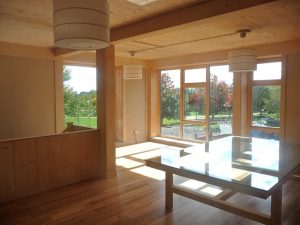The building envelope consists of three main elements: the roof, the walls, and the foundation. The main concerns we have for these building elements are protecting the interior of the home from weather and other environmental issues, slowing the transmission of heat and controlling light, and shedding and removing water in order to not support the growth of mold and subsequent rot. Each element responds in different ways to the surrounding environment, but the connections of each of the elements are where we can focus attention and, potentially, save the most money.
Options for a buildings’ envelope are varied ranging from the more efficient but less typical straw bale home to the standard but less efficient stick frame (wood construction) home. Since there are many home types that are not standard choices for the majority of home buyers I will focus on the more traditional types of construction for this blog. There are some really fun and creative choices for homes, however, and if you are interested, you can visit some websites dedicated to outside-of-the-box construction methods; https://www.wbdg.org/design/env_wall.php, http://earthship.com/, http://www.strawbale.com/, http://www.world-housing.net/wp-content/uploads/2011/06/Adobe_Blondet.pdf, http://www.inspirationgreen.com/earth-sheltered-homes.


The first element we will focus on is the foundation. Typically foundations in the United States are poured concrete. Depending on your soil conditions and frost depth you can have a basement foundation, a crawlspace, or a slab on grade. Assuming there is a basement foundation, for our energy consumption discussion, that can be an area of heat loss due to the location of the heating equipment. Therefore, the foundation would need to be tightly sealed and insulated to reduce heat loss. The following link offers many ways of insulating a foundation wall, and it describes suggestions and methods depending on your regional/local climatic conditions.

http://www.greenbuildingadvisor.com/blogs/dept/musings/how-insulate-basement-wall
Since air will infiltrate your structure at the gaps between materials, there are ways of mitigating the issue. For making sure that you have the best connections between materials for your foundation you will need to air seal it. The following links are handy guides as well:
http://www.finehomebuilding.com/design/departments/energy-smart-details/air-sealing-a-basement.aspx
http://energy.gov/energysaver/types-insulation
http://energy.gov/energysaver/air-sealing-your-home
The next area we will focus on are the walls. Again, it is critical to make sure that you have a tight connection between your foundation and your walls. It is also critical to make sure that any penetrations in your walls are also tight and insulated. If you look at the next link you will see a graphic of areas where insulation is required and needed for your home: http://energy.gov/energysaver/where-insulate-home But, remember, you still want tight connections, sealants at all penetrations, and some sort of moisture control to keep your home energy efficient.
The last area we will focus on is the roof. Again, since heat rises, this can be an area where the efficiency of your structure can be compromised either by having the wrong insulation, not enough insulation, or improper installation of the insulation. A great website for all insulation and sealing of structures can be found at http://www.greenbuildingadvisor.com/green-basics/insulating-roofs-walls-and-floors.
Most importantly, by choosing to insulate and seal your home and by maintaining your homes’ envelope, the informed homeowner can save up to 20% on heating and cooling expenses for the year, which is roughly 10% of your homes’ total energy expenses. So, hopefully, this blog post will be one of the more valuable posts offering money saving information when purchasing, building or renovating your home.









